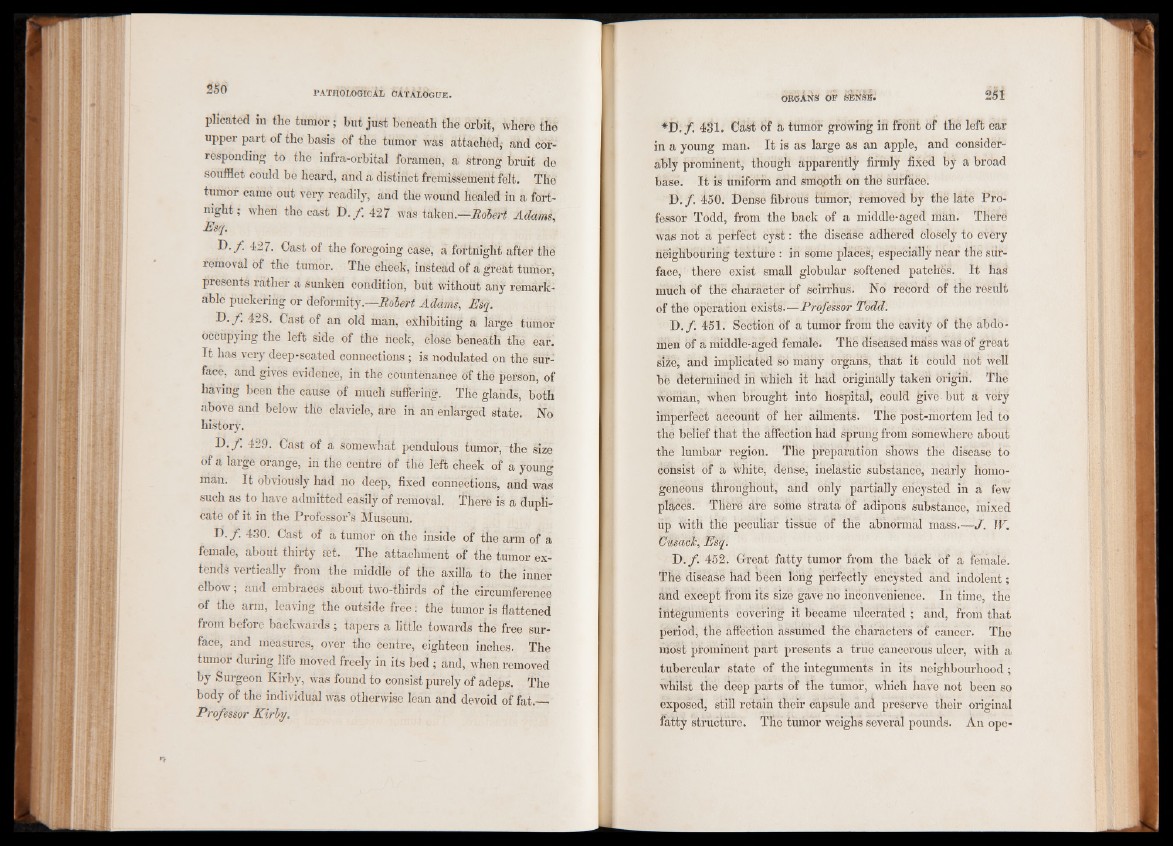
plicated in the tumor; but just beneath the orbit, where the
upper part of the basis of the tumor was attached; and corresponding
to the infra-orbital foramen, a strong bruit de
soufflet could be heard, and a distinct fremisseffierit felt. The
tumor came out very readily, and the wound healed in a fortnight;
when the cast D ./. 427 Esq. was taken.—Robert Adams.
T ).f 427. Cast of the foregoing case, a fortnight after the
removal of the tumor. The cheek, instead of a great tumor,
presents rather a sunken condition, but without any remarkable
puckering or deformity.—Robert Addms, Esq.
D. f 428. Cast of an old man, exhibiting a large tumor
occupying the left side of the neck, close beneath the ear.
It has very deep-seated connections ; is nodulated on the surface,
and gives evidence, in the countenance of the person, of
having been the cause of much suffering. The glands, both
above and below tlie clavicle, are in an enlarged state. No
history.
D. ƒ. 429. Cast of a somewhat pendulous tumor, the size
of a large orange, in the centre of the left cheek of a young
man. It obviously had no deep, fixed connections, ahd was
such as to have admitted easily of removal. There is a duplicate
of it in the Professor’s Museum.
D. /. 430. Cast of a tumor oh the inside of the arm of a
female, about thirty set. The attachment of the tumor extends
vertically from the middle of the axilla tb the inner
elbow; and embraces about two-thirds of the circumference
of the arm, leaving the outside free: the tumor is flattened
from before backwards; tapers a little towards the free surface,
and measures, over the centre, eighteen inches. The
tumor during life moved freely in its bed; and, when removed
by Surgeon Kirby, was found to consist purely of adeps. The
body of the individual was otherwise lean and devoid of fat._
Professor Kirby.
*D. ƒ. 431. Oast bf a tumor growing in front of the left ear
in a young man. It is as large as an apple, and considerably
prominent, though apparently firmly fixed by a broad
basé. It is uniform arid Smb.oth on thè surface.
]). ƒ. 450. Dense fibrous tumor, removed by the late Professor
Todd, from the back of a middle-aged man. There
was not a perfect cyst: the disease adhered closely to every
neighbouring tèxtufe : in some places, especially néar the surface,
there exist small globular softened patches. It has
much of the character bf scirrhus. No record of the result
of the operation exists.—Profeèsor Todd.
D. ƒ. 451. Section bf a tumor from the Cavity of the abdo-
xnën bf a middle-aged female. The diseased mass was of great
size, and implicated so many organs, that it cbUld Hot well
be determined in Which it had originally taken origiti. The
woman, when brought into hospital, could give- but a very
iinperféct account of hér ailments. The post-iriortem led to
thé belief that the affection had sprurig from somewhere about
the lumbar region. The preparation shows the disease to
consist of a white, dense, inelastic substance, nearly homogeneous
throughout, and only partially encysted in a few
places. Thèré are Some strata of adipous substance, mixed
up With thè peculiar tissue of the abribrmal mass.—J. W.
Cu'sacJc, Esq.
D. f. 452. Great fatty tumor from the Back of a female.
The disèasë had bëeri long perfectly èri'cyStéd and indolent;
arid ëxcbpt from its size gave rib inconvenience. In time, the
integuments covering it became ulcerated ; and, from that
period, the affection assumed the characters of cancer. The
most promirierit part presents a tfue cancerous ulcer, with a
tubercular state of the integuments in its neighbourhood;
whilst the dëep parts of the tumor, which have not been so
exposed, still retain their capsule and preserve their original
fatty structure. The tumor weighs several pounds. An ope